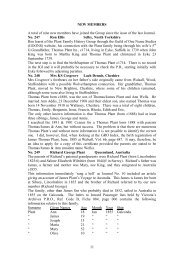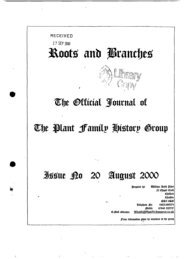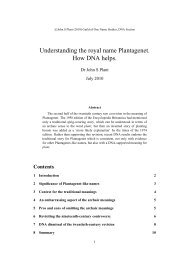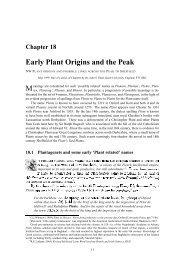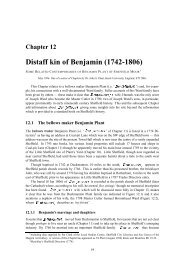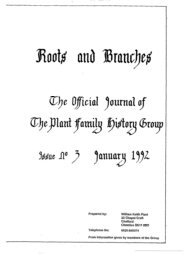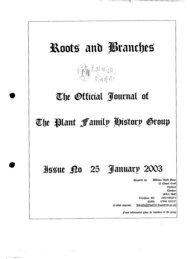Chapter 34 Austin Plant - Plant Family History Group
Chapter 34 Austin Plant - Plant Family History Group
Chapter 34 Austin Plant - Plant Family History Group
Create successful ePaper yourself
Turn your PDF publications into a flip-book with our unique Google optimized e-Paper software.
• though no genealogical evidence would necessarily be expected for scattered bastards, there<br />
is none to prove that <strong>Plant</strong> and <strong>Plant</strong>t descended from <strong>Plant</strong>egenest and <strong>Plant</strong>agenet - a less<br />
presumptuous possibility is that a lesser mortal, perhaps one in awe of <strong>Plant</strong>egenest, fathered<br />
offspring with <strong>Plant</strong> as a surname as this held to the Welsh ‘offspring’ meaning of <strong>Plant</strong> and<br />
also matched the local Child by-name; in addition, the spelling <strong>Plant</strong>t suggests a possible<br />
allegiance to <strong>Plant</strong>egenest’s realm.<br />
Though this leaves just a hint of a possible cultural connection between the names <strong>Plant</strong>agenet<br />
and <strong>Plant</strong>, it is important. This is because the development of the <strong>Plant</strong>agenet surname itself is<br />
controversial and the <strong>Plant</strong> surname can provide a few extra clues.<br />
The name “<strong>Plant</strong>agenet” was originally spelled <strong>Plant</strong>e Genest or <strong>Plant</strong>egenest or <strong>Plant</strong>aginet.<br />
It originated with Geoffrey of Anjou, father of King Henry II who ascended the English throne in<br />
1154. It is most commonly claimed that the name arose because Geoffrey wore a sprig of broom in<br />
his bonnet though perhaps otherwise that he planted it to improve his hunting covers or used broom<br />
to scourge himself. Its significance has been said to relate to its golden flower though, in my latest<br />
Nomina publication, I have postulated that it related culturally to the earlier name <strong>Plant</strong>apilosa and,<br />
thereby, to the development of contemporary belief in the vegetative soul.<br />
Though the name <strong>Plant</strong>agenet has been retroactively applied to the descendants of Geoffrey<br />
<strong>Plant</strong>e Genest of Anjou, there is no contemporary evidence that the royal family used this surname<br />
before the mid fifteenth century; and so evidence for the intervening years of the development of<br />
similar names, such as <strong>Plant</strong>, is amongst the best available evidence when seeking onomastic clues<br />
for the significance of the <strong>Plant</strong>agenet surname. Recent Y-DNA and other evidence suggests a<br />
generative meaning, offspring, to <strong>Plant</strong> [J.S. <strong>Plant</strong> (2005) Nomina 28, pp. 115-33] and this suggests<br />
that generative aspects of the vegetable soul could have played a key role in the development of<br />
the <strong>Plant</strong>agenet surname. This is discussed further in: J.S. <strong>Plant</strong> (2007) ‘The tardy adoption of the<br />
<strong>Plant</strong>agenet surname’, Nomina, to appear in Vol. 30.<br />
The <strong>Plant</strong> name in Nomina publications<br />
by Dr John S <strong>Plant</strong> (Member No 52) March 2007<br />
Nomina is the ‘Journal of the Society for Name Studies in Britain and Ireland’; it has been<br />
published annually since 1977. Its main focus has been on place names though it sometimes accepts<br />
articles about personal names and surnames. As mentioned earlier, I published an article in Volume<br />
28 of that journal:<br />
John S <strong>Plant</strong> (2005) Modern methods and a controversial surname: <strong>Plant</strong>, Nomina, 28, pp. 115-<br />
133.<br />
Since Nomina is a recognised academically and since the subject matter of my article included<br />
some semantics and metaphysics, the article has also been accepted on the eprints web-site for the<br />
Cognitive Sciences, where it appears at:<br />
http://cogprints.org/5462/<br />
By the way, the full text that currently appears there is not quite the final version; just a few changes<br />
were made after I sent the electronic text in to the editor of Nomina for printing.<br />
In June 2006, I asked the editor if she would be interested in a follow-on article about the<br />
<strong>Plant</strong>agenet name; and, after I had put my submission together and the journal referees had peer<br />
reviewed it, it was accepted in February. This second article, though finalised in January, will not<br />
appear in print until around the end of this year, with the title:<br />
John S <strong>Plant</strong> (2007) The tardy adoption of the <strong>Plant</strong>agenet surname, Nomina, 30, pp. 57-84.<br />
57



